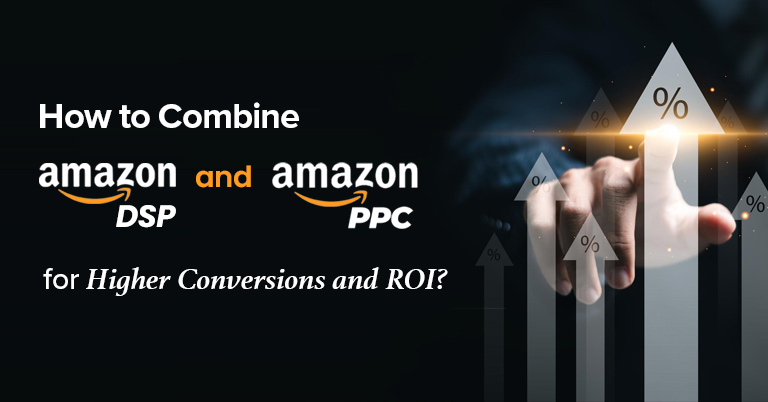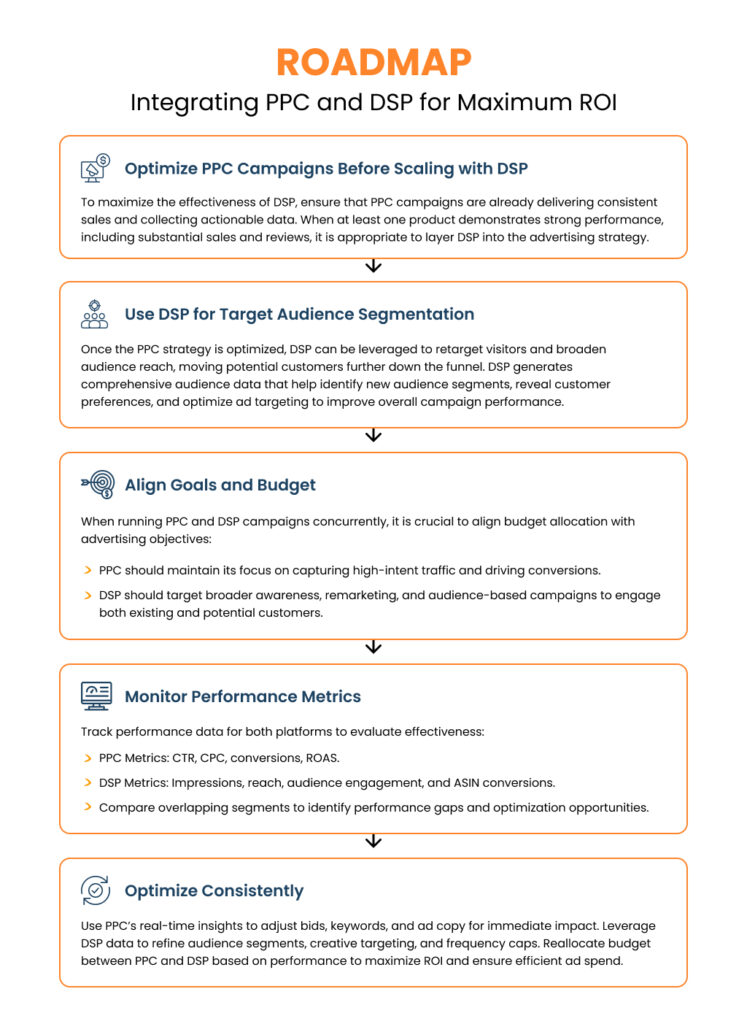
Amazon advertising centered on Pay-Per-Click (PPC) campaigns, while effective for immediate conversions, leaves significant gaps: brands struggle to engage audiences outside of Amazon, retarget visitors who didn’t convert, or build awareness among early-stage shoppers.
Amazon Demand-Side Platform (DSP) addresses these challenges by offering advanced audience targeting and cross-platform retargeting, but it introduces higher costs and delayed performance insights. The solution lies in combining PPC and DSP into a full-funnel marketing strategy—using PPC for high-intent conversions and DSP for brand awareness, retargeting, and audience expansion.
This Amazon advertising 2025 guide examines how these two platforms complement each other, highlights their respective strengths and limitations, and provides a practical roadmap for integrating them to maximize reach, conversions, and ROI.
Table of Content
How Does Amazon DSP and PPC Complement Each Other?
1. PPC’s Limitation: Limited Retargeting and Granular Targeting
PPC campaigns—while effective for capturing high-intent traffic within Amazon—have limitations when it comes to targeting beyond specific keywords and product searches. Modern Sponsored Display ads (part of PPC) do offer limited retargeting both on and off Amazon, but the targeting options still remain less granular compared to DSP.
How Amazon DSP Fills This Gap:
Amazon DSP enables advanced audience targeting based on Amazon’s first-party data, such as customer behavior, interests, and demographics. With DSP, brands can build highly detailed audience segments and target people who have not yet searched for the products but show strong indications of interest. Additionally, DSP enables retargeting past visitors across the web, making it a much more powerful tool for expanding the reach to customers beyond those searching on Amazon.
The Hybrid Approach: PPC campaigns deliver direct, high-conversion targeting, while DSP provides granular, audience-based targeting, reaching shoppers at all stages of the funnel—from active searchers to early-stage prospects.
2. PPC’s Limitation: Limited Reach Beyond Amazon
PPC ads primarily function within Amazon’s platform—meaning that once a shopper leaves Amazon, PPC ads no longer have access to them. While PPC ads, such as Sponsored Display, do extend some reach off-Amazon, it is still relatively limited compared to the expansive possibilities of the Amazon Demand-Side Platform.
How Amazon DSP Fills This Gap:
Amazon DSP enables advertisers to place ads not only on Amazon but also across third-party websites, apps, and streaming services, such as IMDb TV and Amazon Fire TV. This enables brands to reach shoppers outside the Amazon ecosystem, increasing their visibility across multiple touchpoints.
The Hybrid Approach: PPC captures high-intent engagement, while DSP leverages first-party data to retarget customers across other platforms, increasing the likelihood of conversion.
3. Amazon DSP’s Limitation: High Cost of Entry vs. PPC’s Cost-Efficiency
Amazon DSP works on a cost-per-impression model, meaning advertisers are charged each time their ad is served, regardless of whether it receives a click. For many smaller businesses or brands with limited ad budgets, this can make DSP campaigns expensive, limiting accessibility and requiring careful budget planning to ensure a positive return on investment.
How PPC Fills This Gap:
PPC is far more cost-effective for brands with smaller budgets. Since PPC works on a cost-per-click (CPC) basis, advertisers only pay when someone clicks on your ad. PPC is an efficient way to generate immediate sales and visibility on Amazon without the high entry costs required by DSP.
The Hybrid Approach: PPC campaigns drive immediate conversions, while DSP supports brand awareness and retargeting, creating a balanced advertising strategy that optimizes costs and scales brand presence on and off Amazon.
4. Amazon DSP’s Limitation: Delayed Reporting vs. PPC’s Real-Time Optimization
A significant challenge with DSP is the delay in reporting. Some key metrics, such as ASIN conversion data, can take up to 14 days to fully populate, making it difficult for advertisers to make real-time optimizations during a campaign. This delay can hinder rapid adjustments, potentially reducing the effectiveness of ongoing campaigns.
How PPC Fills This Gap:
PPC provides immediate, real-time performance data, allowing advertisers to make quick adjustments to their campaigns—whether that’s adjusting bids or optimizing keywords. This quick feedback loop is crucial for refining the strategy and ensuring effective budget spending.
The Hybrid Approach: Combining Amazon PPC and DSP insights offers PPC’s real-time insights for informed decision-making, while leveraging long-term data insights from DSP to refine broader strategies.
How to Build a Full-Funnel Marketing Strategy?
A full-funnel marketing strategy ensures the brand engages customers at every stage of the buyer’s journey. By combining PPC for high-intent conversions with Amazon DSP for audience targeting and retargeting, sellers can create a seamless system that guides shoppers from awareness to purchase—and even repeat purchases.
Top of Funnel: Awareness
- PPC for Immediate Visibility: Target high-intent shoppers actively searching for products similar to yours. Sponsored Products and Sponsored Brands ads help capture these users, generating immediate traffic and potential conversions.
- Amazon DSP Strategies 2025 for Brand Awareness: Reach broader audiences who may not yet know your brand. Leverage DSP’s demographic, lifestyle, and interest-based targeting to introduce your brand across Amazon-owned sites and external platforms such as third-party websites, apps, and streaming services.
Key Objective: Build initial brand recognition and ensure your products are discoverable by both active and passive shoppers.
Middle of Funnel: Consideration
- Retargeting via Amazon DSP: Engage shoppers who have interacted with your products or visited competitor listings. DSP allows dynamic retargeting across Amazon and external platforms, keeping your brand top of mind while shoppers are still researching.
- Cross-Platform Visibility: Deliver ads in multiple formats—display, video, and OTT—on platforms that PPC cannot reach. This increases engagement and builds trust as users explore options.
- Audience Segmentation: DSP enables targeting of In-Market audiences (actively browsing products in your category) and Lifestyle segments (users whose behaviors indicate potential interest), which PPC alone cannot address efficiently.
Key Objective: Maintain brand presence, build trust, and guide shoppers toward intent to purchase.
Bottom of Funnel: Conversion
- PPC Campaigns for High-Intent Shoppers: Capture customers who are ready to buy, using targeted keywords and products to drive immediate conversions. This remains the most cost-effective way to secure direct sales.
- DSP for Dynamic Retargeting: Serve ads to shoppers who have shown strong buying signals—such as viewing a product detail page, adding items to their cart, or exhibiting previous purchase behavior. Amazon DSP supports personalized messaging, cross-selling, and re-engagement campaigns.
Key Objective: Turn interest into action and maximize ROI on both immediate sales and repeat purchases.
Strategic Integration: How to Combine PPC Campaigns and Amazon DSP for Maximum ROI

1. Optimize PPC Campaigns Before Scaling with DSP
To maximize the effectiveness of DSP, ensure that PPC campaigns are already delivering consistent sales and collecting actionable data. When at least one product demonstrates strong performance, including substantial sales and reviews, it is appropriate to layer DSP into the advertising strategy.
2. Use DSP for Target Audience Segmentatio
Once the PPC strategy is optimized, DSP can be leveraged to retarget visitors and broaden audience reach, moving potential customers further down the funnel. DSP generates comprehensive audience data that help identify new audience segments, reveal customer preferences, and optimize ad targeting to improve overall campaign performance.
3. Align Goals and Budget
When running PPC and DSP campaigns concurrently, it is crucial to align budget allocation with advertising objectives:
- PPC should maintain its focus on capturing high-intent traffic and driving conversions.
- DSP should target broader awareness, remarketing, and audience-based campaigns to engage both existing and potential customers.
4. Monitor Performance Metrics
Track performance data for both platforms to evaluate effectiveness:
- PPC Metrics: CTR, CPC, conversions, ROAS.
- DSP Metrics: Impressions, reach, audience engagement, and ASIN conversions.
Compare overlapping segments to identify performance gaps and optimization opportunities.
5. Optimize Consistently
Use PPC’s real-time insights to adjust bids, keywords, and ad copy for immediate impact. Leverage DSP data to refine audience segments, creative targeting, and frequency caps. Reallocate budget between PPC and DSP based on performance to maximize ROI and ensure efficient ad spend.
Struggling to Maximize Your Amazon Ad Performance?
Leverage professional Amazon PPC agency and DSP services to combine these strategies and engage shoppers at every stage of the funnel, increase conversions, and optimize your ad spend.
